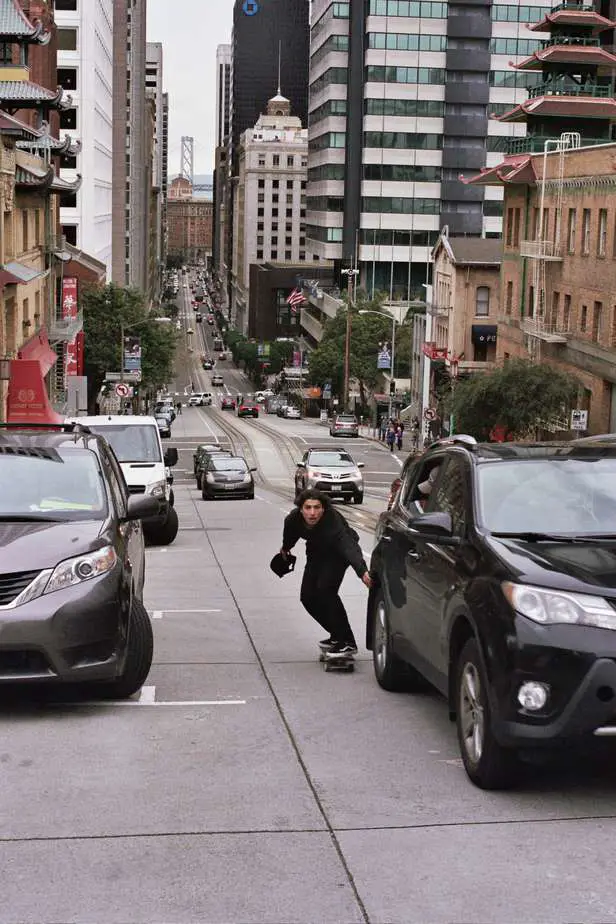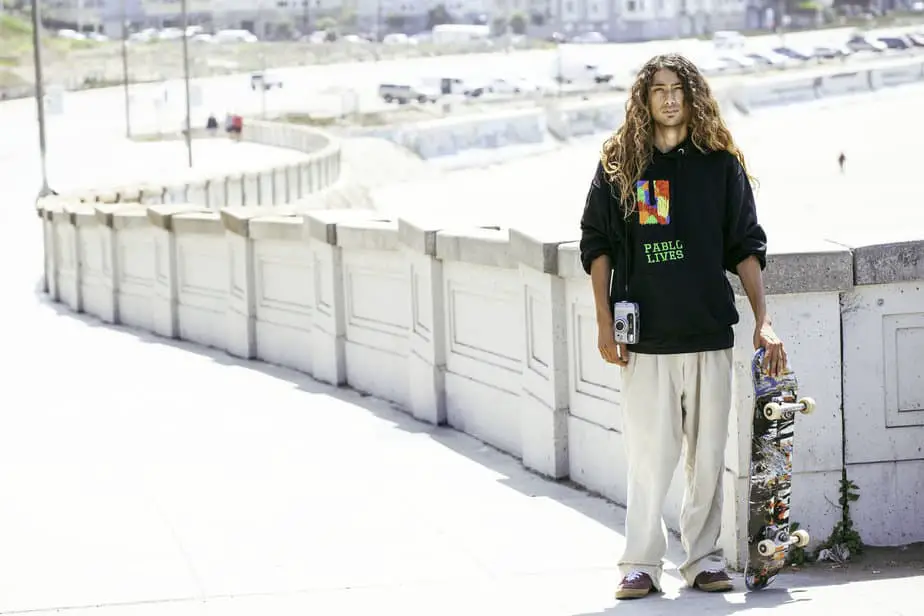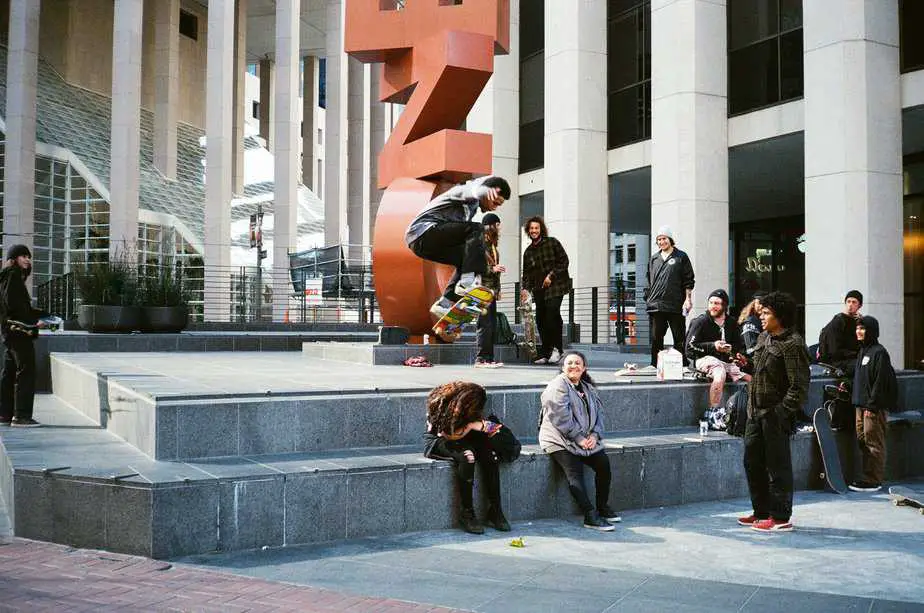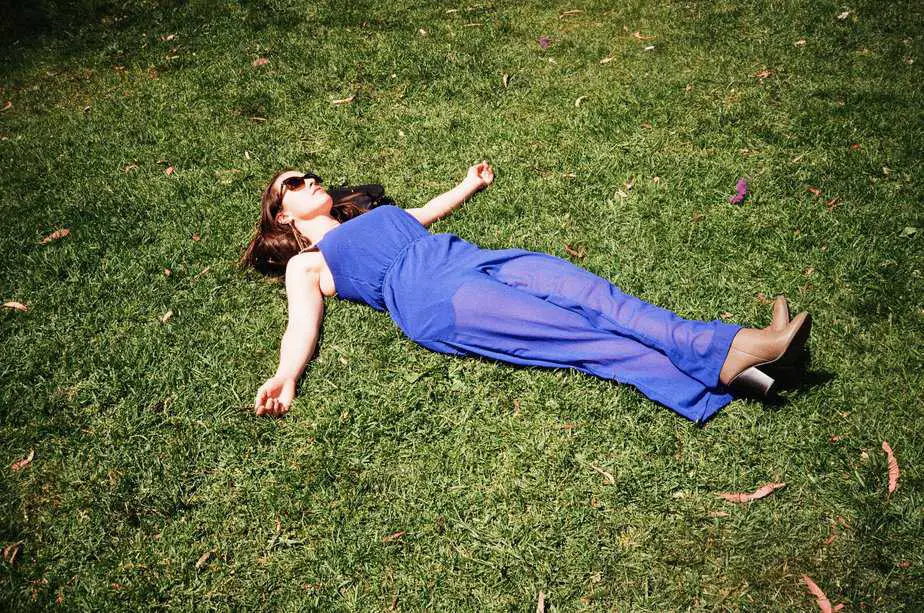James is a native San Franciscan, photographer, and veteran skateboarder. Skating is life, he says, but his other passions put him in more than just one box. He’s got a vivid memory, faith and love for his city, and an almost poetic view of skateboarding. To him, skating, photography, and the city go hand in hand. He can talk forever about any mix of those three. In that tiny cafe, while scarfing down a plate of pancakes, James calls SF one of the freest places to skate.
“The hills float you around to different neighborhoods,” James says of his preferred mode of transportation: the wooden board that sits at his feet. He skates everywhere, and has done so for such a long time that he doesn’t really remember how to pace his gait when he walks.
“If I’m walking,” he shakes his head. “Man, it’s bad. I don’t know how long it’s gonna take me.”
As a commute-by-skateboard guy, he knows the hills and the pavement. While the hills might be an endless source of complaint for other locals driving and walking their way around town, James has befriended the slopes. “In SF, you just stand on your skateboard anywhere, and your board will start rolling. Everywhere you’re standing, your board just starts talking off.”
He’s has been skating since he was around five years old. When he talks about skating as a kid, he doesn’t talk about skateparks—he talks about cruising on the streets in order to get from place to place.
“I have early memories of skating down McAllister as a small kid with a random kid from down the block. And going down Market Street, skating from Western Addition all the way to Market.”
Although he’s one of the few homegrown skaters based in the city, so many other transplant skateboarders share his enthusiasm about San Francisco. For years, the city has been a destination for the sport. People come from all over the US, and the world, to experience what James calls the mecca of skateboarding. Thrasher Magazine is headquartered here. You might be familiar with the hill-bombing antics of famed local skate crew GX1000. You’ve probably seen Instagram clips of them taking Geary by Cliff House or dodging oncoming traffic down California, the rush of the wind and the steady crackle of wheels on pavement dominating the audio track and you may find him occasionally bombing hills with the GX guys. According to Ferrando, San Francisco is, “in many ways, the birthplace of street skating.” And skate history from the golden era of the mid-nineties lives on today in classic spots like the Justin Herman Plaza across the Ferry Building, which James refers to as Emb. Awhile back, the whole place was remodeled and the concrete ledges were covered in metal brackets designed to deter skateboarding. Signs attached to the light posts read that skateboarding is prohibited, but according to James, no one really enforces those rules. Having managed to rip off some of the knobs, locals have reclaimed the plaza. It amazes me how, despite how increasingly inaccessible San Francisco is becoming, skateboarders and skateboarding still thrive here. Knobs can be ripped off; we’ll always need walls and stairs; and the hills—rising costs of living and a changing city don’t take those hills away.
“SF is still one of the most real places to skate, if not the most. Because you go down a hill and you don’t know what’s going to happen. And it’s gnarly,” said James.
Not many people have what it takes to master the big hills of San Francisco on a skateboard. When I come across a video of someone skating a massive hill, I generally will drop what I’m doing and watch intently. The energy is contagious. It’s both thrilling and incredibly nerve-wracking to watch, and today I pick James’ brain in an effort to understand the mechanics of skating the biggest hills.
“You’re having fun at the beginning of it, or maybe—probably the beginning you’re just like looking at it, you’re like, ‘shit.’
It’s a mix of skill and pure guts. It’s common to station spotters at the intersections to make the ride as safe as possible, but once you get going, you’re in it for the ride—despite the cars and stoplights that might get in your way. Depending on how fast you’re going, you can try to slow your speed. It takes concentration to simply keep your feet on the board as you zoom down the incline.
“It becomes a game of survival. You’re trying to hang on as much as you’re trying to control, and that’s where it gets super instinctual and primal. You just get this crazy wave of adrenaline, and it just feels insane to blast a crosswalk going so fast.”
To James, skateboarding is a connection to the street. When you skate from place to place, you see everything. You’re living more. You’re present, truly seeing things all the time; you’re paying attention to the people around you, the buildings, everything down to the cracks in the sidewalk and the swells of the pavement under your feet. James shared an insane analogy that helped me understand just how skateboarding shaped him as a person and photographer.
“When you’re skating, you’re on a different time schedule. You know how people in space on a rocket—if they come back you’re like, all old, but they’re still young, because they’ve been traveling at the speed of light?” he explains. “I forget, some kind of theory. But that’s like when you’re on a skateboard. So you’re going fast all the time, see, you’re living a little faster, a little more than other people who aren’t going at that speed.”
And you, dear reader, know as much as anyone that there is something interesting going on on practically every corner of this city. The characters and contours of the city live deep in James’ memory, and he vividly remembers everyday scenes on SF streets from his toddler years.
“Some people can’t remember a lot from that age. But I could remember seeing hella things just being out and about,” Ferrando says. “So like when you see SF or you see the streets or people living like that so freely at a young age, it’s like, whoa. And you see what’s cool, or at least I did. And so I took that with me.”
The city as he knows it is always a source of inspiration: “You see things all the time you realize that are too good. You’re like, this is too good. Someone needs to have the camera right now.” He tried his hand at photography for the first time in the fall of 2016. He’s been shooting film ever since. This past year, James has found himself on a regular photo route through the Tenderloin. I tag along one Monday. We start at Civic Center, weave through the heart of the TL up to the Union Square area, and then trail Market until we hit Embarcadero. The light’s good at this time of day, he tells me. We turn a corner and I can see why he’s chosen this path. As I look down the street, the storefronts, signs, and faces appear in their full glory in the four-o-clock sun. He tells me that he usually skates this route, but on account of my presence, he has to walk it, skateboard in one hand and camera in the other.
“The TL is a super interesting group of people,” he tells me. “You kind of have to have the ins; you have to be comfortable enough and people have to be comfortable enough with you for you to be on the street right there. Because it’s just a regular neighborhood,” he says.
James has a knack for capturing everyday moments and photographing the varied characters of San Francisco. His photography doesn’t create any illusions about the people, or the city. Each figure that plays a part in his photos is an everyday part of San Francisco. The people in his photos are not always the subjects per se—they’re a piece of the larger moment he’s capturing.
James walks slowly—especially when we wade through the crowds of FiDi folk rushing home, he appears as though he’s floating amongst the suited and heeled folk. There is one moment along the route where he starts speedwalking, and it’s to catch the lighting. He observes a one-footed pigeon, recounting an obscure fact about the crazy birds and how natural selection turned the city birds grey during the Industrial Revolution.
“Birds by Market are crazy. They get a little better by Golden Gate Park,” he notes.
We stop at several points—to dash into a bodega (James buys a pastry), to pop into liquor store (just because it’s interesting), and then to listen to a man playing the trumpet on a street corner. We listen to him play for a bit. As we walk away from the scene, James recalls the times he’s seen the trumpet player on Fillmore. He points to that moment on the corner as uniquely SF. Usually, he’ll also find himself dashing into the See’s store on Market to grab samples, but today it’s slipped his mind.
As the light softens, and the FiDi crowds thicken, James reflects on the idiosyncracies of shooting in the afternoon. It’s a different boat altogether from shooting early in the day. He compares it to how it feels when you skate in the morning: everything about it screams a new day. When you push, you forget how far you can go. You can take on a fast hill without the inhibition of a midday mindset. Your legs might still be waking up, but your brain is primed and ready to take on a new day and to live all those daily experiences again.
As a photographer and human skating through the world, James is finely attuned to the little details. Perhaps he has a photographic memory. I think it’s equally possible that the things most important to us structure our memory, and James just deeply treasures his craft. Either way, his recent experiences are closely intertwined with those photographic compositions. James recalls photos of his late friend, Pablo, down to the visual elements of the shot. James recalls the exact day they met, down to the date.
“That was the same time I started shooting photos learning how to shoot photos. First real black and white I ever shot was photos of him [doing] sidewalk bombs on Peru Street,” James says. He treasures these flicks (as he calls them) as documentation of the important, yet fleeting moments of life.
“It means a lot to me to see these photos. We’re all getting older, so fast. It just preserves the history of my time. I could look at a day that I was skating with people, and I’ll remember everything about the day. And that’s like, everything about film—I’ll look at the roll of film and I instantly know everything that happened. It’s like a time machine.”
The following week, James and I talk on the phone. He picks up from his place in the Outer Richmond—he is very psyched about his new framing skills. He’s hyped, and for the first time, framing it himself really puts the wheels in motion of his love for photography.
“Here, I’m gonna send you a photo of this thing. I wanna show you what I just did.” James texts me a photo—it’s a picture of his friend, Pablo, on his skateboard, grabbing onto a car to catch a ride up California. The frame is a dark wood and the mat is a striking forest green.
“I’m trying to step it up as an artist,” he says. To him, that means starting to do all steps of the process himself. Developing his own photos, framing, and installing his own work according to the professional conventions of the art world. And along with that, developing his own unique vision of presentation.
I ask him what the future looks like. The dream is financial independence with his art. Right now, he juggles his photography with a bike food delivery job—a good life filled with what James calls “subsisting vibes.” And he has a few exciting opportunities lined up for the next few months, art and otherwise. The far future doesn’t seem like a burden to him; it’s more like new territory to live even bigger than before. Fresh off a month of travel, James has energy for newness.
“I’ve been here forever. I’m ready to see things and experience things that I haven’t before. I was doing that for 24 days in New York… that was the first time I ever did anything like that for that long, and it really opened my eyes to what’s really possible, you know, and priorities and goals and what I really want to be doing. All at the same time trying to put more things out, take more photos, skate, and kind of elevate myself as an artist by doing more hands on stuff.”
He’ll keep going, doing pretty much what he’s always done. As that saying goes—trust the process. Maybe James would say to trust the momentum.
“With skating… there’s plenty of ways to make it within. It’s all cumulative progress. You just keep hitting one big trick after another… Just like with being an artist… the more you show, the more people expect to see. Everything is momentum.”
// Check out either of his Instagram accounts @subsistfilmphoto and @sub_sist1 for more. Message James if you’re interested in buying a print. Header photo by Mark Fore.




